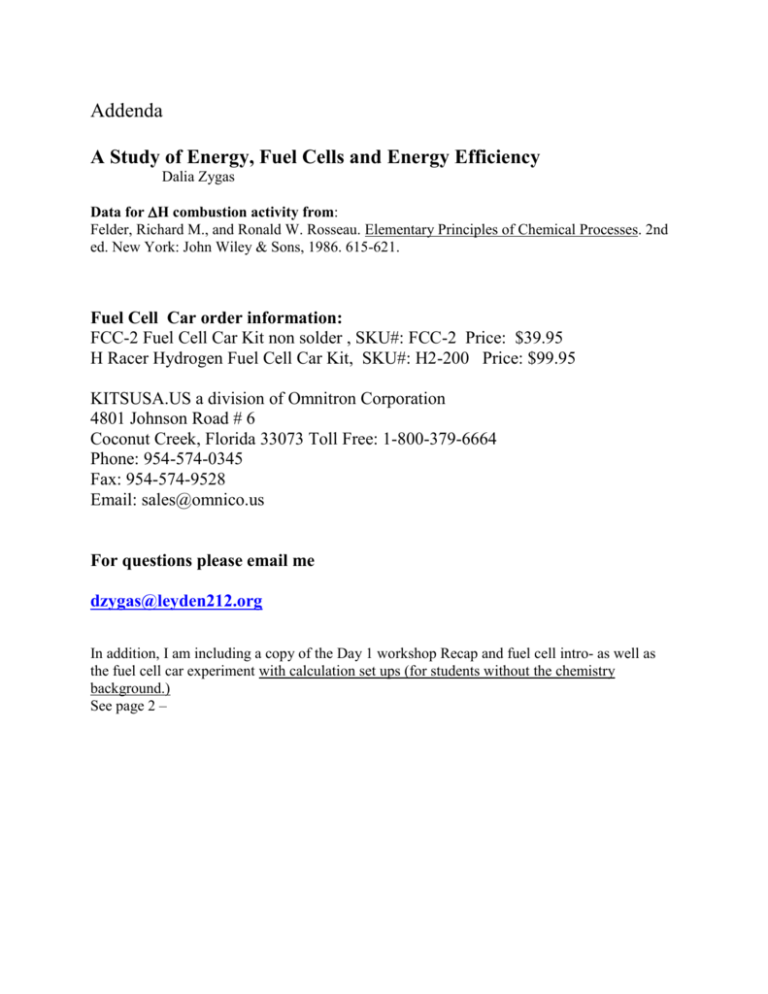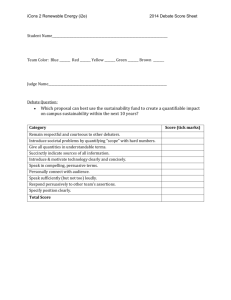Addenda
advertisement

Addenda A Study of Energy, Fuel Cells and Energy Efficiency Dalia Zygas Data for H combustion activity from: Felder, Richard M., and Ronald W. Rosseau. Elementary Principles of Chemical Processes. 2nd ed. New York: John Wiley & Sons, 1986. 615-621. Fuel Cell Car order information: FCC-2 Fuel Cell Car Kit non solder , SKU#: FCC-2 Price: $39.95 H Racer Hydrogen Fuel Cell Car Kit, SKU#: H2-200 Price: $99.95 KITSUSA.US a division of Omnitron Corporation 4801 Johnson Road # 6 Coconut Creek, Florida 33073 Toll Free: 1-800-379-6664 Phone: 954-574-0345 Fax: 954-574-9528 Email: sales@omnico.us For questions please email me dzygas@leyden212.org In addition, I am including a copy of the Day 1 workshop Recap and fuel cell intro- as well as the fuel cell car experiment with calculation set ups (for students without the chemistry background.) See page 2 – Fuel Cell Workshop – Day 1 Recap 1. Breaking bonds requires adding energy- forming bonds ________ energy. 2. To find H we subtract energy of bonds broken- energy of bonds formed. a) If the energy is needed to break the bonds is greater than the energy released when the bonds are formed, the sign of H is ___________ and the reaction is called endothermic. b) If the energy is needed to break the bonds is less than the energy released when the bonds are formed, the sign of H is ___________ and the reaction is called exothermic 3. Different fuels release different amounts of energy when they are burned. Which of our fuels released the most energy? ______________________________ 4. When hydrocarbons (propane and gasoline are examples) are burned , what are the products? (What is formed?) _____________________________________________ 5. When hydrogen burns, what is formed? ________________________________ Fuel Cell Intro Fuel cells generate electrical power quietly and efficiently, without pollution. A fuel cell converts the chemicals hydrogen and oxygen into water, and in the process it produces electricity. It does not actually BURN the hydrogen- but the energy released by this reaction is the same as if it was burned. The fuel cells in your car use electrical energy (batteries ) or solar energy to split water into hydrogen and oxygen. 2 H2O 2 H2 + O2 Endothermic The car then uses the hydrogen in the reverse reaction to form water again. The energy released in this reaction is ( in theroy) equal to the energy used to split the water up. 2 H2 + O2 2 H2O Exothermic As you can imagine, ALL of the energy does not get converted 100%. This is why we want to examine- how much of the energy that is put into a system ends up being useful- doing what engineers call “work”. Fuel Cell Car Experiment We will use a car which is powered by a hydrogen fuel cell and measure its efficiency in a manner similar to the Hero’s engine lab. 1. Obtain a (Intelligent) fuel cell car- make sure that the fuel cell has been hydrated with distilled water. Try the car out- make the hydrogen using the fuel cell, and use the hydrogen to see how the car works. 2. When you try our your fuel cell car you must have a group member designated to stop the vehicle- this group member is constantly watching so that the car does not go off of the lab counter. 3. Connect your fuel cell to the power source (most likely a power pack with AA batteries). You should see hydrogen and oxygen being produced immediately. Let the power supply go until you have produced between 25-30 mL of hydrogen. Read and record the hydrogen volume. 4. You will be using a small piece of tape and some cord to attach paper clips to the fuel cell car. Before attaching those items, find their total mass, being careful not to attach the tape to the balance. 5. Attach the cord (with the paper clips) through the pulley and over the side of the lab counter. Have a meter stick in place to measure the final height of the paper clips. Adjust your set up so that the string is taut. When your group is ready to time your trial- turn the car on, and time how long it took to lift up the paper clips. Turn the car off immediately and record the hydrogen level. 6. Repeat this trial up to 3 times, (as time allows), keeping track of the hydrogen. Record the initial hydrogen level, record the time needed to raise the paper clips the entire 1 meter, and the final hydrogen level. If the clips do not make it to the 1 meter mark, record the distance they are lifted as well. Record any relevant observations- i.e. car traveled at an angle, wheels slipped, etc. 7. Use the same tape and set up to try out the H racer. Measure the time that it takes to raise the same load (clips and cord and tape). Data Trial 1 Trial 2 Trial 3 H racer X X X X X X Initial H2 level Final H2 level Time elapsed Distance paper clips lifted Room temperature Atmospheric pressure Observations Fuel Cell Car Experiment Calculations Energy in = energy out We will calculate energy in as the amount of energy released when hydrogen and oxygen react to form water. Energy in= energy released in the formation of water from H2 and O2 = H per mole of hydrogen reacted (J/mol) x moles of H2 used Calculate the volume of H2 used in each trial by subtracting the initial and final volumes for that trial. Example = 30 mL – 23 mL = 7 mL Convert your volumes to L by dividing each volume by 1000. Example= 18 mL = 0.018 L Use the ideal gas law, the lab temperature and pressure, and find the moles of H2. Trial 1 PV= nRT, n = PV = ( 1 atm) ( L) = RT ( 0.0821 L atm/mol K) (295 K) moles n = PV = ( 1 atm) ( L) = RT ( 0.0821 L atm/mol K) (295 K) moles n = PV = ( 1 atm) ( L) = RT ( 0.0821 L atm/mol K) (295 K) moles Trial 2 PV= nRT, Trial 3 PV= nRT, For each trial, calculate the energy in by multiplying H (485 kJ /2 mol for H2) x moles of H2 to get the energy that was entering the fuel cell. Trial 1 (485 kJ) x ____________________ moles H2 = 2 mole kJ Trial 2 (485 kJ) x ____________________ moles H2 = 2 mole kJ Trial 3 (485 kJ) x ____________________ moles H2 = 2 mole kJ Next, we will look at the energy going out of your system. Energy out = work + heat Calculate how much work your engine did. The formula for work is Work = F d = m a d ( Work is force times distance, force is mass times acceleration- these are all formulas which you will use a lot in physics!) To find the work, multiply the mass of your paper clips ( in kg) times the acceleration due to gravity ( this is the force your engine worked “against”) 9.8 m/sec2 times the distance that your paper clips moved, in m. The answer will be in the units of kg m2/sec2 which is equal to Joules. Trial 1 Work = F d = m a d Work = ________________ kg x 9.8 m sec 2 x __________________m = J x __________________m = J x __________________m = J Trial 2 Work = F d = m a d Work = ________________ kg x 9.8 m sec 2 Trial 3 Work = F d = m a d Work = ________________ kg x 9.8 m sec 2 Calculate the efficiency of your fuel cell car. Show all set ups. You must make sure that the units are the same- either change J to kJ ( by dividing by 1000) or change kJ to J by multiplying by 1000. It does not matter which you do- just make sure they “match” and therefore cancel. Trial 1 Efficiency = useful work out = energy in Trial 2 Efficiency = useful work out = energy in Trial 3 Efficiency = useful work out = energy in Why was it much more difficult to measure the energy in for the H racer? What might be some solutions?





